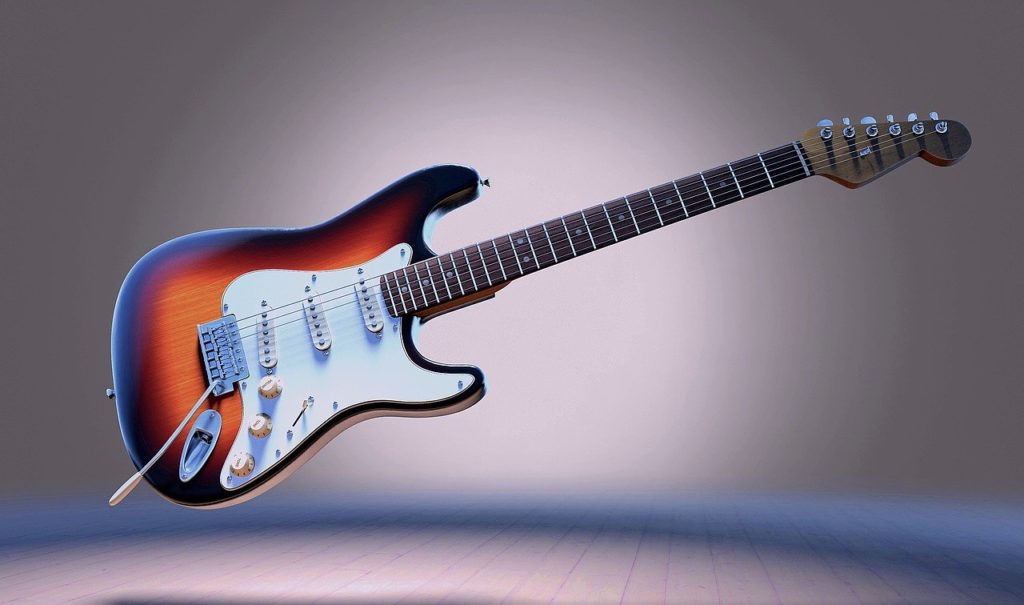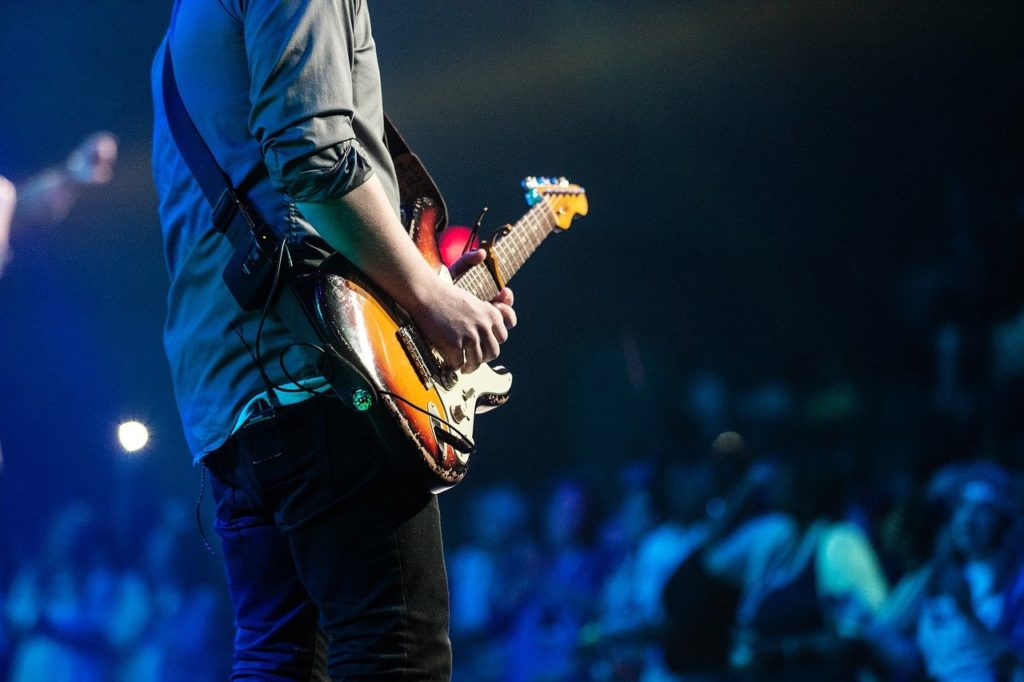The B major scale is a commonly used scale. It’s a diatonic scale, meaning it consists of 5 whole steps and 2 half steps. The notes of the B Major Scale are:
B
C#
D#
E
F#
G#
A#
The B major scale is heptatonic. It is made up of 7 unique notes with the 8th, the second B, being an octave higher than the first. Looking at the notes in the scale you’ll count 5 sharps. In sheet music 5 sharps indicates that it is the B Major Scale.
The B Major Scale on Guitar

Figure 1 is a chart representing the fretboard of a guitar. The root note, B, is indicated in red. This scale pattern is based on a guitar in standard tuning. The pattern starts over at the 13th fret Looking closely you can make out the positions of the CAGED Method, but more on that later.
The B major scale is used when a song is played in the key of B. A song in the key of B is rooted with the B major chord. B major is one of the more difficult of beginner chords but with a little bit of practice you can play it fluently in no time.
The difficulty with the B major, and minor, chord is it has no “open position”. These open position chords are affectionately referred to as “Cowboy Chords”. They’re simple to play and always the first chords learned for new players.
The next “level” of chords typically learned are barre chords and this is where you’ll find B major. Barre chords are played by using your index finger to depress multiple strings in a single fret while simultaneously further fretting with one or more remaining fingers.

Figure 2 shows how to play the B major chord in the first position. B major can be played all down the fret board but this is the first place on the neck you can combine the notes in the scale that make up the major chord. It’s a good place to start the groundwork for a backing track when you want to start playing solos and the best way to do that is using the CAGED Method.
How Do You Play the B Major Scale on Guitar?
The easiest way to learn how to play any scale is by using the CAGED Method. This method works across multiple scales which makes it a useful tool to learn.

In figure 3 you can see the finger placement for the open position of the CAGED Method. I have placed a red dot over the root note, B.
Figure 1.2 is a clipped image of the first figure. It illustrates the notes that will be played by using the chart in figure 3. A good place to start practicing is playing the scale from figure 3 up and down and repeat it over and over increasing in speed as you accomplish fluency.
Next, we’ll move to the third position, so-called as the 3rd fret is the lowest fret in the series. You’ll note that as you progress up the neck the positions overlap.

Again, I’ve placed red dots over the root notes. For this position you want to start with your index finger on the 4th fret and playing the 6th string. Continue on the 6th string placing your ring finger on the 6th fret and pinky on the 7th. The numbers on the dots indicate the placement for each assigned finger down to the high E string.
Figure 1.3
Figure 1.3 is another cropped image of figure 1. Use this as you play the notes in the 3rdposition. If you haven’t memorized the notes on the fretboard yet, I would recommend calling the notes out loud as you play them. Memorizing the notes of the fretboard is one of the most important aspects in becoming fluent in your playing. What will further help is learning the notes of each key and the best way to do that is understanding the formula for how those notes are determined.
What Notes Are in the B Major Scale?
As stated above, the notes in the B major scale are:
I-B
II-C#
III-D#
IV-E
V-F#
VI-G#
VII-A#
VII-B
These notes are not unique to this scale but how they’re arranged are. Every key has itsroot note, the note the scale is named after, in this case it’s B. Every scale also has what is called a Relative Key. This is a scale that contains all the same notes but a different root.
The relative key for every major scale is called its relative minor. The relative minor for B Major is G# minor, you can see how the notes in this scale are arranged below.
I-G#
II-A#
III-B
IV-C#
V-D#
VI-E
VII-F#
As stated, the notes are the same but how they’re built is different. Every Major scale works off the same formula. To find out the notes in any major scale simply choose your root note and apply the formula.
For B major you start at B and use the major key formula. The formula consists of intervals, the distance between two pitches, used to reach the next note. The major scale intervals are, Whole(W)-Whole(W)-Half(H)-Whole(W)-Whole(W)-Whole(W)-Half(H). This is most often abbreviated by the initial of each word, (WWHWWWH).
Though B major and its relative minor scale share the same notes, the formula on which they are built is different. If you want to know how the notes in G# minor scale are determined, you can start (here), at our lesson on the C minor scale.
How Do You Solo in the B Major Scale?
One of the best parts of learning guitar is learning how to solo. Watching rock stars like Slash, Clapton, and Dimebag Darrel, to name a few, work their magic on stage looks like the ultimate freedom. But how do they do it? How to solo is up to the individual but the fundamental tool they all start with is scales.
Again, the best place to start is by using the CAGED Method as partly described above. In the previous figures I show you the shapes and the individual notes that make up the B major scale. Here, I’ll take you a step further and show you the tablature.
Tablature is a way of notating music that indicates what fret to depress.

Figure 5 demonstrates the fretting of two octaves of the B major scale in the open position. Starting at the ‘2’ on the 5th string at the far left of the tablature is a B. The proceeding notes are
C#
D#
E
F#
G#
A#
B- octave
C#
D#
E
F#
G#
The tab then reverses to its starting point, ascending in pitch then descending in pitch back to the original B. Practice and memorize this tablature, increasing in speed as you increase in accuracy. Accuracy is the most important characteristic of your playing, then speed.
The ‘key’ to soloing is improvising. You want to practice this scale with a backing track in the key of B. A popular chord progression in the key of B is, I-III-IV-V. That is to say,
B
D#m
E
F#
Once you have this backing track start to play the notes in the open position shown in the tablature above. Work on different rhythms and melodies and listen to what sounds good. As you get accustomed to the open position, apply the CAGED Method further down the neck and open the sounds that come with the higher pitches.
There are hundreds of popular songs in the Key of B. After you’ve increased your skill with a backing track, try your hand at some of your favorite popular music. Some of the most popular songs in the Key of B are:
Heart-Shaped Box by Nirvana
Thunderstruck by AC/DC
November Rain by Guns N Roses
Poker Face by Lady Gaga



